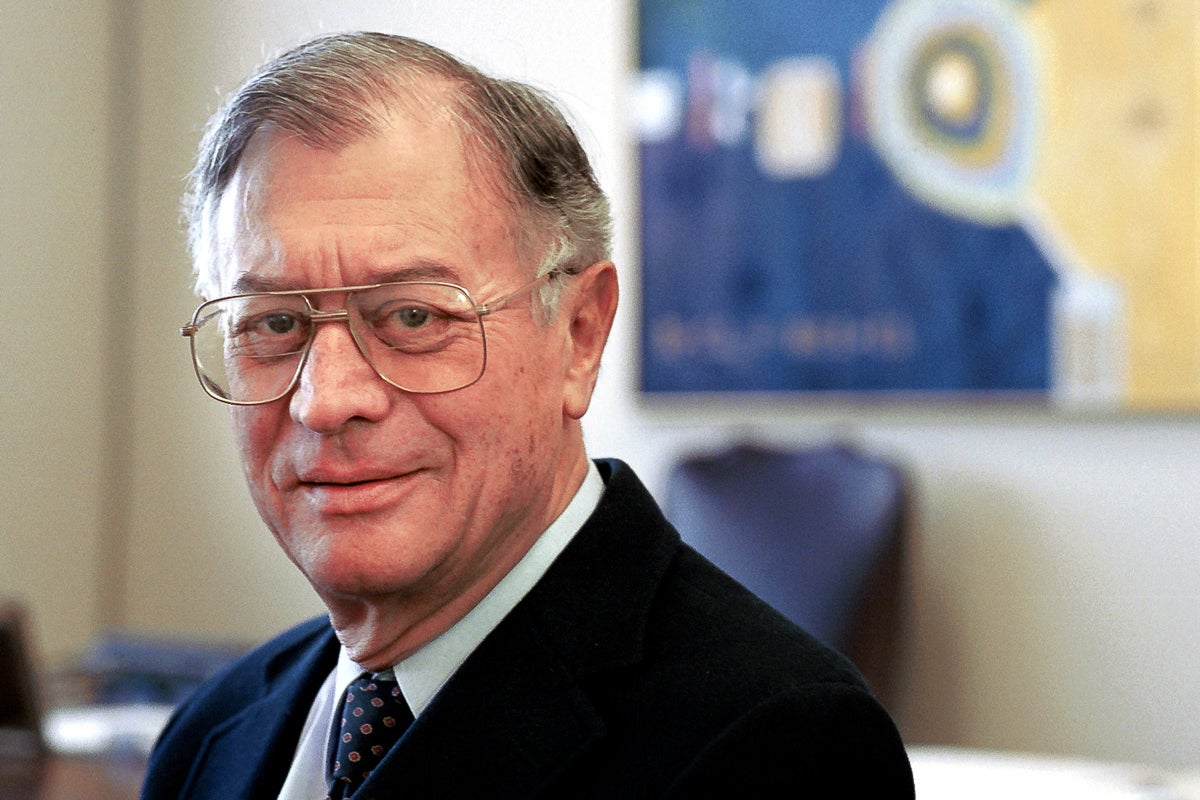Pioneering Stanford physical chemist John Ross dies at 90
John Ross, a professor of chemistry at Stanford and recipient of the National Medal of Science, was a forward-thinking researcher known also for his humor and wisdom. He passed away after a brief illness on Feb. 18 at the age of 90.
John Ross, the Camille and Henry Dreyfus Professor of Chemistry, Emeritus, at Stanford University, was a visionary in the field of physical chemistry. His research focused on molecular studies, statistical mechanics and nonlinear kinetics and inspired new routes of inquiry in his field and beyond. A National Medal of Science recipient for his trailblazing work, Ross was also a revered collaborator, teacher and mentor. Following a brief illness, Ross passed away Feb. 18 in Palo Alto at the age of 90.

John Ross, 1926-2017 (Image credit: L.A. Cicero)
“Ross was one of the most original and profound thinkers in the world in chemical science,” said Ross’s colleague and friend, John Brauman, professor emeritus of chemistry at Stanford. “He continually made major theoretical and experimental contributions in reaction kinetics and dynamics that have changed the way we think about chemical reactivity and allowed us to understand why many chemical phenomena occur.”
Born in Vienna on Oct. 2, 1926, Ross left Austria due to religious persecution a few days before the outbreak of World War II and settled in New York with his parents. Majoring in chemistry at Queens College, he interrupted his education to serve in the Army from 1944 to 1946, during which time he was one of the first soldiers to see the devastation in Hiroshima.
After graduating with his Bachelor of Science degree in 1948 from Queens College, he entered the Massachusetts Institute of Technology (MIT), where he studied gas transport properties under physical chemist Isadore Amdur and earned a PhD in 1950. Subsequently, he worked on gas thermometry and on the statistical mechanical theory of irreversible processes as a postdoctoral fellow with physical chemist John G. Kirkwood at Yale University.
Faculty career
Ross began his faculty career as an assistant professor in chemistry at Brown University in 1953. There, he launched a program to test the viscosity of liquids as a function of temperature and pressure with unprecedented precision. Two years later, he and physical chemist Edward Greene began nearly two decades of groundbreaking work developing the use of molecular beams to investigate molecular dynamics – revealing details of molecular collisions, dispersion and other interactions during chemical reactions.
In 1966, Ross joined the chemistry department faculty at MIT, where he served as chair from 1966 to 1971. He came to Stanford University in 1980 as a professor of chemistry and was department chair from 1983 to 1989.
In his research at Stanford, Ross examined new experimental and theoretical approaches to the determination of complex reaction mechanisms, the thermodynamics and statistical mechanics of systems far from equilibrium, and the application of these studies to biological reaction mechanisms. His work was groundbreaking in that he looked at chemical reactions as a whole, applying inputs and correlating those with outputs, instead of breaking them down into simpler parts.
Ross’s contributions in reaction kinetics and dynamics changed chemists’ understanding of reactivity and why many chemical phenomena occur, opening new fields in the chemical and biological sciences. This work was far ahead of its time and is now used in many different disciplines.
“Ross was a giant in the area of physical chemistry, having made pioneering theoretical and experimental studies in chemical kinetics, which is the study of how fast and by what means chemical transformations take place,” said Richard Zare, professor of chemistry and another Stanford faculty colleague. “Ross’s work is most definitely changing the way we think about and understand chemical reactivity.”
Among many honors recognizing his broad and extensive contributions in physical chemistry, Ross was elected to the National Academy of Sciences and the American Academy of Arts and Sciences; he received the U.S. National Medal of Science in 2000 from President Clinton.
An engaging collaborator
In addition to the ambitious research he pursued, Ross welcomed the chance to mentor and work with others. A much-valued collaborator and critic, he wrote or co-wrote 445 original research papers as well as a highly regarded textbook on physical chemistry. At Stanford, he received the Dean’s Award for Distinguished Teaching. In the nominations for this award, students wrote that Ross was “an exceptional, supportive and enthusiastic professor.” They also praised him for his amusing teaching style and penchant for sprinkling lectures with engaging stories, which he was known for outside the classroom as well.
“Ross had a marvelous sense of humor,” said Robert Pecora, professor emeritus of chemistry at Stanford who was a friend and colleague of Ross’s. “He delighted in telling stories – of which he had many – and dispensing wonderful bits of wisdom.”
Ross was preceded in death by his daughter, Elizabeth Ann Ross, who passed in 1998. He is survived by his second wife, Eva, who also left Austria because of religious persecution, and his son, Bob, of Sea Ranch, California, from his first marriage to Virginia Franklin.
